Starfleet Forces
Created by Commodore Wilkan Targaryen on Fri May 23rd, 2025 @ 9:16pm
Starfleet Forces
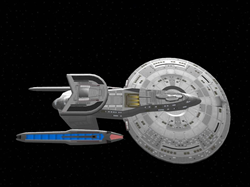 | |
| Type: | Battleship |
| Complement: | 1,150 personnel |
| Dimensions: | Beam: 561 meters Length: 765 meters Height: 138 meters |
| Armament: | Phaser Arrays Phaser Banks Point Defense Turrets Torpedo Launchers |
| Performance: | Warp 9.98 Quantum Slipstream |
| Naming: | Political Terms |
Commonwealth Class Battleship
The largest vessel currently produced by Starfleet, the Commonwealth Class Battleship is one of the most advanced ships currently being built by the Federation. Launched in 2434 for testing, the Commonwealth Class is the most resource intensive design currently used by Starfleet and the resources needed to keep this ship functional is equal to a full squadron of heavy cruisers. Because of their resource cost, only a few members of this design were ever constructed.Built alongside the Intrepid II and the Leonidas Class, the Commonwealth Class was intended to tackle the most complicated and dangerous missions that Starfleet sent its way. A direct response to the larger, more complex threats encountered by Starfleet in the late 24th and early 25th Centuries, ships of the Commonwealth Class were intended to be able to hold their own against significant threats. Each Commonwealth Class ship has been built with time honored equipment and technologies, optimizing the chances of the vessel surviving against extreme dangers that it encounters. Additionally, the inclusion of a mission configurable pod on the dorsal surface of the ship, increases its options prior to deployment.
While they are primarily tactically oriented, Commonwealth Class ships also are equipped for diplomatic and scientific assignments equivalent to any other starship. Despite their capabilities, Commonwealth Class ships are typically assigned to missions within Federation territory or locations where the situation could become untenable quickly. While you may more commonly see a Century, Galaxy III, or a Pandora Class handling diplomatic or strategic crisis for the Federation, the presence of a Commonwealth Class ship makes it clear that the Federation takes the situation seriously and that they are not afraid to commit a critical asset to reach their objectives.
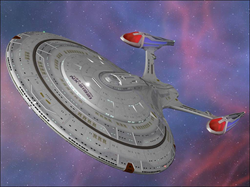 | |
| Type: | Dreadnought |
| Complement: | 825 personnel |
| Dimensions: | Beam: 278 meters Length: 702 meters Height: 85 meters |
| Armament: | Phaser Arrays Point Defense Turrets Torpedo Launchers |
| Performance: | Warp 9.992 Coaxial Warp (Enterprise) Quantum Slipstream |
| Naming: | Historic Vessels |
Century Class Dreadnought
Intended as a replacement for the Ross Class Starship as the Federation’s primary exploratory vessel, the Century Class was a result of Starfleet forces being outmatched and outmaneuvered by technologically sophisticated opponents in the late 24th and early 25th Centuries. First launched in 2436 and formally commissioned in 2439, the Century Class Dreadnought is the culmination of decades of research conducted by the Advanced Starship Design Bureau and the Theoretical Propulsion Group to produce a starship capable of acting as a mobile Starfleet Headquarters, including the necessary capabilities and technologies to ensure mission objectives were met and the Federation's goals achieved.Initial design proposals for the Century Class called for the vessel to include enhanced capabilities over its counterparts as the Federation's flagship class, but it would only field a minimal increase in firepower compared to Starfleet's cruiser class starships. As work progressed, however, Starfleet Intelligence and Starfleet Tactical Operations found current proposals to be inadequate after other races began launching dreadnoughts with greater firepower. Through updated design briefs, the Century Class would represent the maximum levels of offensive technologies capable of being used within the dreadnought hull without impacting the craft's humanitarian capabilities. Within its current mission profile, the Century Class incorporates advanced sensors to support extended exploratory missions (up to and including five-year missions) as well as potential military operations in unexplored territory.
While Century Class vessels are exceptional exploratory platforms, where they truly shine is in their technical acumen. The Century is equipped with an abundance of bleeding edge technologies, including prototype equipment, that allow for testing in practical conditions. Even with this, Century Class vessels are designed with deep space operations in mind and vessels offer their crew easy access to critical systems as well as multiple redundancies that allow it to withstand severe damage that would cripple other vessels. These advancements allow Century Class ships to represent the Federation and its interests for longer duration than their counterparts, even in extreme circumstances.
For more information on the Century Class, please see the Project Longshot LCARS Database.
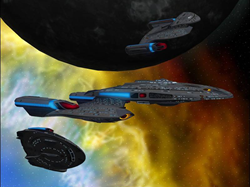 | |
| Type: | Carrier |
| Complement: | 930 personnel |
| Dimensions: | Beam: 441 meters Length: 602 meters Height: 135 meters |
| Armament: | Phaser Arrays Point Defense Turrets Torpedo Launchers |
| Performance: | Warp 9.83 |
| Naming: | Exploration Concepts |
Galaxy III Class Carrier
Originally intended to serve as Starfleet's next generation research and exploration vessel, the Galaxy III Class is the latest in the venerable Galaxy Class line of deep space explorers. Launched in 2433 amidst much fanfare, the Galaxy III Class has already proven itself as an invaluable asset within Starfleet's armada.Earlier Galaxy Class vessels were designed to fulfill a variety of mission profiles; however, the Galaxy III Class is better suited for tactical operations than its predecessors. With a growing number of its enemies using smaller, disposable craft, Starfleet Command realized the need to field a dedicated carrier vessel for the first time since the Typhon Class of the 24th Century. Thanks to its size, the Galaxy was modified to fulfill this need and would be redesigned to include large, well-supplied hangars that would allow it to support a high number of active shuttle missions simultaneously. Thanks to these large storage areas, the Galaxy III excels in missions supporting colonies and responding to crisis situations. Often, however, these ships are relegated from their exploratory role to supportive assignments.
While the Galaxy III is one of the largest starships currently in use by Starfleet, it's design has actually made it slightly smaller than previous Galaxy Class ships. Further, despite outwardly appearing to be well armed, the Galaxy III's Phaser and Torpedo systems are better suited for supporting fleet missions and the ship often relies on its fighters for offense. By default the Phasers aboard the Galaxy III are set Point Defense, destroying incoming torpedoes before they could do any damage.
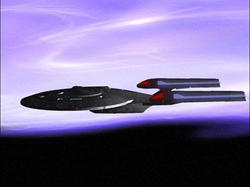 | |
| Type: | Battle Cruiser |
| Complement: | 675 personnel |
| Dimensions: | Beam: 225 meters Length: 570 meters Height: 69 meters |
| Armament: | Phaser Arrays Torpedo Launchers |
| Performance: | Warp 9.977 Quantum Slipstream |
| Naming: | Mythology |
Pandora Class Battle Cruiser
The Pandora Class Battle Cruiser was originally designed as a lower cost alternative to the Century Class, and the two vessels share many of the same advanced technologies with the Pandora serving as a cost-effective platform better suited for universal production and deployment. Roughly 80% of the size of the Century Class, design and construction of the Pandora began after its larger cousin, but the first Pandora Class vessels were first launched in 2435 and christened the following year before their counterparts.Highly versatile starships, Pandora Class vessels are armed with the same powerful Phasers and Quantum Torpedoes as the Century, but in a more modest package. While the Pandora sacrifices some of its tactical capabilities, it is no less deadly in combat and is ideal in strategic assignments. Often, Pandora Class ships are the first to respond to a crisis and are able to quickly deploy the resources necessary to handle an emergency situation due in part to their high attainable speeds.
The Pandora sets itself apart from its counterparts through its configurable mission profile and the design incorporates multiple empty compartments that can be converted based upon need in a pinch. These configurable compartments help contribute to the scientific ability of the Pandora, allowing laboratories to be established as needed depending upon the needs of an assignment. This modularity allows the Pandora to enhance its scientific acumen, rivaling even the Century Class in capability when these modules are fully employed.
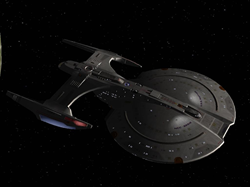 | |
| Type: | Heavy Cruiser |
| Complement: | 650 personnel |
| Dimensions: | Beam: 366 meters Length: 536 meters Height: 81 meters |
| Armament: | Phaser Arrays Torpedo Launchers |
| Performance: | Warp 9.971 Quantum Slipstream |
| Naming: | Soldiers |
Leonidas Class Heavy Cruiser
Designed to complement the Commonwealth Class Battleship, the Leonidas Class was designed to be the spiritual successor to Starfleet's Akira Class Cruiser. Working alongside the Intrepid II Class, the Leonidas was planned to relieve the Commonwealth Class of many of its lighter mission profiles so that their crews could focus on more complicated assignments impacting the Federation's future while the Leonidas and its crews worked on the more routine missions.Designed to be the workhorse of Starfleet's future, the Leonidas Class was launched in 2433 and has been designed to maximize its survivability and functionality, with the crew having easy access to the ship's equipment at all times. Members of the Leonidas Class utilize traditional equipment that has been rigorously tested to ensure its functionality, with multiple backup systems available to take over should the primary system fail for any reason. As a front-line vessel that could face combat at a moment's notice, these redundancies are even more important for the survivability of the ship and its crew, who are typically away from Federation territory in interstellar space. While the Leonidas is a robust vessel, in combat these ships rely more on their toughness and on the flexibility of its power usage, coupled with its Phasers and Photon Torpedoes, to survive the challenges that the frontier has to offer.
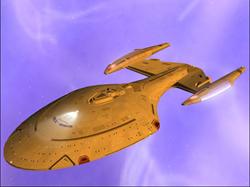 | |
| Type: | Cruiser |
| Complement: | 400 personnel |
| Dimensions: | Beam: 200 meters Length: 515 meters Height: 80 meters |
| Armament: | Phaser Arrays Torpedo Launchers |
| Performance: | Warp 9.983 Quantum Slipstream |
| Naming: | Space Probes |
Intrepid II Class Cruiser
Introduced in 2432, the Intrepid II Class was designed as replacement for its predecessors in the Intrepid and Pathfinder Classes. Incorporating advanced technologies and dedicated personnel, Starfleet's plan was for these vessels to serve at the edge of Federation space where they would be at the forefront of first contact missions with previously unencountered civilizations.While Starfleet's first Intrepid Class vessels were smaller, more compact and streamlined vessels featuring numerous new technologies, the Intrepid II Class was designed as a larger vessel that would be capable of longer duration missions incorporating tried and tested equipment. Designed alongside the Commonwealth and Leonidas Class starships, members of the Intrepid II Class were created to be fast and highly maneuverable craft. Like their predecessors, the Intrepid II also incorporated greater control over their propulsion systems, allowing them to reconfigure their Warp Core geometry to provide maximum warp at less power to conserve fuel, which was vital on the long duration missions that these cruisers would be assigned to. Despite this, several members of the Intrepid II Class have been outfitted with a Quantum Slipstream Burst Drive, discovered by the Intrepid Class Starship Voyager while lost in the Delta Quadrant.
Intrepid II Class ships incorporate sophisticated sensor arrays and laboratories compared to other vessels of their size. These sensors come in handy as they, often, allow the Intrepid II to detect threats prior to them placing the ship and its crew in danger. Should the Intrepid II need to engage in combat, however, it is armed with both Phasers and Photon torpedoes to aid in its survival.
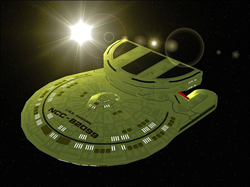 | |
| Type: | Light Cruiser |
| Complement: | 490 personnel |
| Dimensions: | Beam: 239 meters Length: 331 meters Height: 81 meters |
| Armament: | Phaser Arrays Torpedo Launchers |
| Performance: | Warp 9.88 |
| Naming: | Scientists |
T'Kumbra Class Light Cruiser
Sharing many of the same design cues as the Nebula Class Starship of the 24th Century, the T'Kumbra Class Light Cruiser is often referred to as a "pocket Nebula" by older Starfleet personnel. Launched in 2431, the T'Kumbra Class is the first of the current generation of starships being built by the Federation and is a sought after posting for scientists and explorers.Designed alongside the Gol Class, the defining feature of the T'Kumbra Class is its Mission Configurable Pod located on the dorsal surface of the craft. A holdover from the Nebula Class, the configurable pod allows the T'Kumbra to be fitted for any mission profile that Starfleet requires the ship to undertake. Commonly, T'Kumbra Class vessels are launched with a dedicated Sensor Pod that increases their sensor range; however, it is not uncommon for science vessels to be outfitted with a laboratory or medical pod for their assignments. Should the T'Kumbra Class face combat scenarios, the ship can be fitted with a Tactical Pod that is designed to enhance the tactical abilities of the ship to match a Battle Cruiser in capability.
While the variety of mission profiles that a T'Kumbra Class can undertake make it one of the most versatile ships in Starfleet, the T'Kumbra itself is still structurally limited. While she is defended by a Metaphasic Shield Grid, the weak armor of the T'Kumbra prevents it from being a viable combat-oriented vessel without the appropriate pod.
 | |
| Type: | Escort |
| Complement: | 66 personnel |
| Dimensions: | Beam: 166 meters Length: 211 meters Height: 36 meters |
| Armament: | Phaser Arrays Pulse Phaser Cannons Torpedo Launchers |
| Performance: | Warp 9.76 |
| Naming: | Adjectives |
Valiant Class Escort
Named in honor of the Defiant Class Starship U.S.S. Valiant lost in the Dominion War, the Valiant Class is the modern successor to the Defiant Class of the 24th Century. First commissioned in 2432, development of the Valiant Class is in direct response to Starfleet forces being outmatched and outmaneuvered by its opponents in the late 24th and early 25th Centuries and features enhanced weapons and defenses when compared to contemporary vessels.One of Starfleet's truly tactical oriented designs, the Valiant Class is a heavily armed and armored spacecraft that is extremely maneuverable at sublight speeds. Members of the Valiant Class are typically assigned to a law enforcement role, operating along the borders of the Federation to help maintain the safety and security of the Federation's territory. During normal operations, the Valiant is capable of maintaining independent operations for up to two years away from Starfleet support with only the very largest combat capable craft posing as a true challenge to the ship's safety during a fight.
While the Valiant is a warship first, the design has been outfitted with scientific capabilities exceeding the reconnaissance-oriented abilities of its immediate predecessor. These advancements allow the Valiant to undertake scientific survey missions involving the study of strange phenomena and the ability to support ongoing research missions, but only on a short-term basis until a dedicated survey vessel can be dispatched and arrive on scene. These same capabilities make the Valiant ideal for espionage missions as these ships can use their technologies to monitor targets at a distance. Further, Valiant Class starships are fast and maneuverable and incorporate advanced countermeasures within their hulls, allowing these ships to travel very close to and enemy or their territory without being caught by their target's sensors, making them ideal for monitoring assignments.
 | |
| Type: | Destroyer |
| Complement: | 36 personnel |
| Dimensions: | Beam: 95 meters Length: 120 meters Height: 21 meters |
| Armament: | Pulse Phaser Cannons Torpedo Launchers |
| Performance: | Warp 9.63 |
| Naming: | Starfleet Officers |
Sentinel Class Destroyer
Designed in parallel to the Valiant Class Escort, the Sentinel Class Destroyer was a competing design to serve as the replacement for the venerable Defiant Class of the 24th Century as Starfleet's premiere escort vessel.Designed with many of the same advanced components, systems, and design features as the Valiant Class, the Sentinel Class is capable of many of the same mission profiles as the Valiant but on a more modest scale. Where the two classes diverge is the Sentinel's capabilities are far less generalized than those of the Valiant Class and are better suited for intelligence and tactical assignments. The Sentinel is equipped with high resolution sensors that gather large amounts of data both quickly and efficiently and has the added benefit of having a reduced sensor profile due to its small size compared to other craft. These advantages, coupled with the advanced alloys used in the Sentinel's construction, make the vessel difficult for others to detect through traditional methods.
Despite being a tactically oriented vessel, the Sentinel features a reduced weapons loadout compared to traditional destroyer styled craft. In its default configuration the Sentinel is equipped with forward firing pulse phasers on its bow and fore and aft Torpedo Launchers, but makes up for this through its incredible maneuverability and is a deceptively dangerous foe.
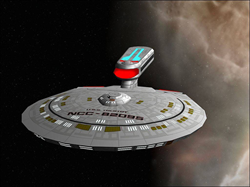 | |
| Type: | Frigate |
| Complement: | 195 personnel |
| Dimensions: | Beam: 239 meters Length: 320 meters Height: 60 meters |
| Armament: | Phaser Arrays Torpedo Launcher |
| Performance: | Warp 9.79 |
| Naming: | Cities |
Gol Class Frigate
Utilizing the same structural components as the T'Kumbra Class, the Gol Class Frigate is a light patrol vessel that was first launched from the 40 Eridani A Starfleet Construction Yards at Vulcan in 2431. Commonly, vessels of this class undertake secondary assignments previously handled by the California and Reliant Classes and may incorporate department coloring on their hulls.As a contemporary of the T'Kumbra Class design, the Gol Class was created to utilize the same hull components as the larger light cruiser design. Early design testing showed that the Gol Class would be effective at patrol and escort missions; however, Starfleet soon realized that the reduced engine power available to the design made the full use of its weapon systems often impractical, limiting the offensive abilities of the design. Despite this the large Saucer Module allows the Gol to take considerable damage when under attack, allowing it to maintain its systems longer without losing system's efficiency.
While the Gol Class has limited tactical abilities, the ship was expected to carry out essentially the same research and exploration missions as its larger counterparts. To meet this requirement, the Gol has the same laboratory facilities and sensor components of its cousins aboard. These enhanced sensors often help to protect the Gol from danger as the crew have the opportunity to detect a threat before it becomes a danger, giving the crew a chance to flee or call for help.
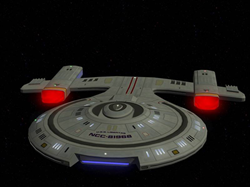 | |
| Type: | Scout |
| Complement: | 30 personnel |
| Dimensions: | Beam: 75 meters Length: 100 meters Height: 13 meters |
| Armament: | Phaaser Arrays |
| Performance: | Warp 9.4 |
| Naming: | Astronomers |
Libertas Class Scout
Designed to replace the Federation's aging Nova Class, the Libertas Class fills Starfleet's need for a small, agile craft capable of performing planetary research, reconnaissance, and short-range exploration assignments. The first generation of Libertas Class ships were commissioned in 2435 and the craft is quickly becoming one of the most abundant designs within Starfleet.Featuring an atypical, integrated design the Libertas is a scout vessel that features twin Impulse Engines and Warp Nacelles that have been specially designed to operate at lower power levels to reduce the strain on the ship's reactors, a critical design feature due to the limited room for additional fuel stores aboard the ship. This also has the added benefit of giving the ship a slim sensor profile, increasing the difficulty for others to detect the vessel at a distance. This is especially helpful for the crew of the Libertas as it is not designed for combat operations and would be quickly overwhelmed by an enemy due to its limited tactical suite. The Libertas further compensates for this deficit through the inclusion of Metaphasic Shielding by default, a powerful shield system capable of withstanding the pressure, radiation, and energy released from a star's corona, and is also highly maneuverable at sublight speeds.
Categories: No categories found